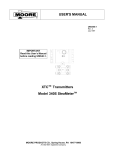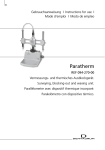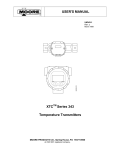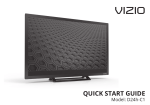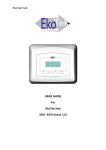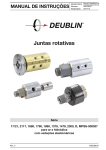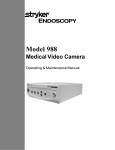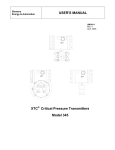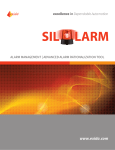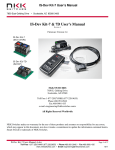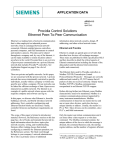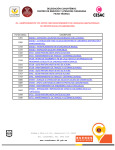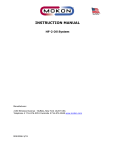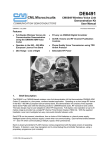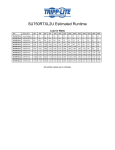Download USER`S MANUAL XTC Transmitters Model 340W Venturi Flow
Transcript
USER'S MANUAL UM340W-1 Read this User's Manual before reading UM340-1. Rev: 2 February 2000 XTCTM Transmitters Model 340W Venturi Flow Transmitter UM340W-1 CONTENTS TABLE OF CONTENTS SECTION AND TITLE PAGE 1.0 INTRODUCTION .......................................................................................................................1-1 1.1 PRODUCT DESCRIPTION ......................................................................................................1-1 1.2 EQUIPMENT DELIVERY AND HANDLING ..........................................................................1-1 2.0 INSTALLATION ........................................................................................................................2-1 2.1 MECHANICAL.........................................................................................................................2-1 2.1.1 Transmitter..........................................................................................................................2-1 2.1.2 Pressure Sensors..................................................................................................................2-2 2.1.2.1 Determining Sensor Depth.............................................................................................2-2 2.1.2.2 Pressure Sensor Installation...........................................................................................2-3 2.1.2.3 Pressure Sensor Removal ..............................................................................................2-4 2.2 ELECTRICAL...........................................................................................................................2-5 2.2.1 Two-Wire Transmitter .........................................................................................................2-5 2.2.2 Four-Wire Transmitter.........................................................................................................2-5 2.2.3 Transient & Lightning Protection .........................................................................................2-5 3.0 CALIBRATION AND MAINTENANCE...................................................................................3-1 3.1 QUICK SET-UP & CALIBRATION .........................................................................................3-1 3.1.1 Zero The Transmitter...........................................................................................................3-1 3.1.2 Span The Transmitter ..........................................................................................................3-1 3.2 ADVANCED SET-UP & CALIBRATION ................................................................................3-1 3.3 MAINTENANCE ......................................................................................................................3-2 4.0 MODEL DESIGNATION AND SPECIFICATIONS ................................................................4-1 4.1 MODEL DESIGNATION..........................................................................................................4-1 4.2 ACCESSORIES.........................................................................................................................4-2 4.3 PERFORMANCE SPECIFICATIONS ......................................................................................4-2 4.4 FUNCTIONAL SPECIFICATIONS ..........................................................................................4-3 4.5 MECHANICAL SPECIFICATIONS .........................................................................................4-3 4.6 HAZARDOUS AREA CLASSIFICATION/APPROVALS ........................................................4-4 4.6.1 CSA Hazardous Locations Precautions ................................................................................4-4 Changes for Revision 2 of this User’s Manual Table 4-1 Model 340W, Model Designation was updated. The Moore logo is a registered trademark of Moore Products Co. XTC and Smart Display are trademarks of Moore Products Co. All other trademarks are the property of their respective owners. Moore Products assumes no responsibility for errors or omissions in this document or for the application and use of information included in this document. The information herein is subject to change without notice. February 2000 i CONTENTS ii UM340W-1 February 2000 UM340W-1 INTRODUCTION 1.0 INTRODUCTION This manual is for use with the Moore Products Co. Model 340W Venturi Flow Transmitter. It contains installation, calibration and service information specific to the Model 340W. Two User’s Manuals are included in a Model 340W shipment: • UM340W-1, this manual, contains Model 340W specific information and references to sections in the accompanying UM340-1. • UM340-1, User’s Manual, XTC Transmitters, Series 340 Pressure Transmitter-Controllers contains information that applies to all Series 340 Transmitters, such as: - product support options (Section 1.4) - installation wiring diagrams (Section 4) - configuration procedures using the Model 275 Universal HART® Communicator and the local magnetic switches (Section 6) - troubleshooting techniques (Section 7) Read UM340W-1 first since it contains the Model 340W specific information. IMPORTANT Save this User’s Manual for installing, configuring, operating, and servicing a Model 340W transmitter. 1.1 PRODUCT DESCRIPTION The Model 340W Venturi Flow Transmitter measures flow through a venturi primary flow element. Designed specifically to retrofit existing BIF® SBF II Metering Systems, the Model 340W combines a Moore Products Co. XTC Series differential pressure transmitter with two remote pressure sensors. These sensors are either 10.5" (267 mm) or 14" (356 mm) long with a 0.75" (19 mm) diameter. They are connected to the transmitter by an armored capillary system. A diagram of the transmitter is shown in Figure 1-1 on the following page. Each pressure sensor mounts into a venturi through an O-ring gland and valve assembly, called a corporation cock. The sensor mounts flush with the inside of the venturi, and can be removed while the venturi remains in service. Standard sensors have a 316 SS body and a 316L SS diaphragm. The Model 340W is a smart transmitter that uses the HART protocol for communicating with other devices, such as the Model 275 Communicator, other hand held configuration devices, and panel board instruments. The 4-20 mA output from the transmitter can be configured to be linear with differential pressure or flow. This makes the Model 340W a direct replacement for any conventional or smart transmitter. 1.2 EQUIPMENT DELIVERY AND HANDLING The capillary tubes and diaphragms can be damaged if the transmitter is mishandled. A kinked capillary or damaged diaphragm can not be repaired. If damaged, the entire transmitter assembly must be returned to the factory and the damaged parts replaced. CAUTION Never allow the transmitter or a pressure sensor to hang unsupported from the armored capillary. This can result in permanent damage to the system. February 2000 1-1 INTRODUCTION UM340W-1 CAUTION Do not remove the protective cover from a pressure sensor. A diaphragm is very sensitive. A crease or nick in a diaphragm can cause measurement inconsistencies and lead to premature failure of the sensor. Use extreme care when handling the pressure sensors. Refer to UM340-1, Section 4.1 for additional information concerning equipment delivery and handling. 5.46 (138.68) 4.39 (111.5) 1.75 (44.5) Req'd to Remove Cap NEMA 4X IP67/68 Enclosure Electrical Entrance 1/2-14 NPT or M20 X 1.5 Tapped Hole, 2 Places 0.50 (12.7) 0.75 (19.1) 3.50 (88.9) Dia Armored S.S. Capillary Fill Port Sensor Connection 6.43 (163.3) 2.38 (60.5) 1 (25.4) User Selectable 2.13 (54.1) Mounting Bracket 48 (1219) 7/16-20 Tapped Hole, 8 Places 10.5 (266.7) 316 S.S. Sensor Body 0.750 (19.1) 3.13 (79.5) 3.56 (90.4) 3.50 (88.9) 2.75 (69.9) 3.50 (88.9) 0.745 (18.9) 2.75 (69.9) 0.760 (19.3) 316 S.S. Diaphragm 1/4-20 thread, Collars to Set Depth 1 place for & Connect Linkage linkage Notes: 1. Dimensions are in inches (millimeters). 2. S.S.= Stainless Steel. 0.375 (9.5) 3.69 (93.7) O-Ring Seal Retraction Groove 7/16-20 Bolts & Lockwashers Included Linkage 3/4 NPT O-Ring Gland Hex Head, Cut Away to Show Seal 1/4-20 Thread 6 places for Connecting Linkage 4.50 (114.3) X03022S1 FIGURE 1-1 Model 340W Venturi Flow Transmitter 1-2 February 2000 UM340W-1 INSTALLATION 2.0 INSTALLATION The following supplements the installation procedures provided in UM340-1. Become familiar with the contents of UM340-1, Section 4.0 Installation before continuing. 2.1 MECHANICAL This section describes installation of the transmitter and pressure sensors. Pressure sensor removal is also described. See Figure 1-1 for dimensions and assembly details while performing the mechanical installation. The capillary tubes and diaphragms can be damaged if the transmitter is mishandled. A kinked capillary or damaged diaphragm can not be repaired. The entire transmitter must be returned to the factory and the damaged part replaced. CAUTION Never allow the transmitter or a pressure sensor to hang unsupported from the armored capillary. This can result in permanent damage to the system. Do not remove the protective cover from a pressure sensor until asked to in a procedure. A diaphragm is very sensitive. A crease or nick in a diaphragm can cause measurement inconsistencies and lead to premature failure of the sensor. Use extreme care when handling the pressure sensors. REPLACEMENT INSTALLATIONS If the Model 340W at hand is replacing another transmitter, measure and record the insertion length of each installed sensor before removal. This should be measured as the distance from the tip of the pressure sensor to the stop collar. Be sure to clearly label each distance as the inlet or throat sensor dimension. These dimensions will be needed in Section 2.1.2.2. If the transmitter has already been removed, an alternative procedure can be found in Section 2.1.2.1. 2.1.1 Transmitter Secure the transmitter to a permanent object, typically a 2" pipe or a venturi tube. Transmitter orientation will not affect transmitter operation, however: • Electrical entrances must be accessible for wiring and servicing. • The terminal end of the enclosure must be accessible for wiring and servicing. • If a smart display is included, orient the transmitter so the display can be easily read. The display can be rotated as described in UM340-1, Section 4.6. 2" PIPE MOUNT Refer to UM340-1, Section 4.4.1 for a detailed 2" pipe mounting procedure. Follow the Model 340D instructions. UNIVERSAL VENTURI TUBE Use a right-angle adapter bracket to mount the 340W directly to a Universal Venturi® Tube, manufactured by BIF. This Tube has an integral mounting pad. See Figure 2-1. February 2000 2-1 INSTALLATION UM340W-1 1. Mount the bracket to the venturi tube with four (4) user-supplied 5/16 - 18 x 1/2 bolts and lockwashers. 2. Secure the transmitter to the mounting bracket with 7/16 - 20 x 3/4 bolts and lockwashers. Model 340W Min. Radius= 1 1/2" (38.1) Capillary Tubing TOP VIEW HP LP Pressure Sensor O-Ring Gland Corp Cock Center Line of Tube X03023S0 FIGURE 2-1 Typical Venturi Tube Installation 2.1.2 Pressure Sensors Installed pressure sensors should appear as shown in Figure 2-1. This section provides installation and removal procedures for the pressure sensors. CAUTION The diaphragm at the end of a pressure sensor is very sensitive. A crease or nick in a diaphragm can cause measurement inconsistencies and lead to premature failure of the sensor. Use extreme care when handling a pressure sensor. 2.1.2.1 Determining Sensor Depth If the required insertion length is not known, as in the case of a new installation, follow the procedure below to determine the depth. 1. Following plant and process procedures, shut-off the process upstream of the venturi and empty the venturi of any process material. WARNING Failure to perform the above step can expose personnel to hazardous process material or to process material under high pressure or at extreme temperature. 2. Obtain a straight, stiff wire that is at least 13" (330 mm) long (e.g., a straightened metal coat hanger). Form a 90º bend in one end, approximately 3/8" (10 mm) long. 3. Insert the hooked end of the wire through the O-ring gland and opened corporation cock until certain the hooked end is into the venturi. 2-2 February 2000 UM340W-1 INSTALLATION 4. Slowly draw the wire out of the venturi until you feel the hook catch the edge. Hold the wire at this point. 5. Mark the wire where it exits the O-ring gland. 6. Carefully remove the wire from the venturi and assembly. 7. Measure and record the required insertion length as the distance from the 90º bend to your mark on the wire. 8. Follow this procedure for both the inlet and throat pressure taps. 2.1.2.2 Pressure Sensor Installation Install the high pressure sensor in the inlet section pressure tap. The high pressure sensor can be located by looking at the transmitter body, between the process flanges. A triangle with an ‘H’ in its center points to the high pressure sensor. Install the low pressure sensor in the throat section pressure tap. To install a pressure sensor follow the procedure outlined below. This procedure assumes the venturi is full and the corporation cock closed. NOTE The line pressure should be less than 50 psig (345 kPa) for installation or removal of a pressure sensor to reduce the chance of personal injury. 1. On each pressure sensor, measure and mark the correct insertion depth as determined earlier (in Section 2.1 or 2.1.2.1). Mark the high pressure sensor with the inlet section insertion length. Mark the low pressure sensor with the throat section insertion length. 2. Use a 3/16" Allen wrench to loosen the insertion depth (inner) collar and slide it forward to your mark. Tighten the insertion depth collar. This collar sets the insertion depth for a flush mount with the inside venturi wall. 3. Next loosen and move the restraining linkage (outer) collar to near the capillary end of the pressure sensor. Placement of this collar is not critical at this point. 4. Remove the protective cover from the diaphragm end of the sensor. 5. Near the diaphragm end of the sensor, lightly grease about 1/2" (12 mm) of the sensor body - do not grease the diaphragm. 6. Insert the pressure sensor into the O-ring gland until the groove on the sensor body is at the edge of the O-ring gland. This will be a firm fit as the sealing O-ring is inside the gland. 7. Attach the restraining linkage to the restraining linkage (outer) collar and the O-ring gland. Adjust the pivot points and restraining linkage collar as necessary so the linkage fits as shown in the lower diagram in Figure 2-2. Hand-tighten the linkage bolts, the restraining linkage collar can be secured. The restraining linkage prevents the sensor from being forced out of the assembly by the process pressure during installation and removal. 8. Open the corporation cock. 9. Carefully push the pressure sensor the remaining distance into the assembly until the insertion depth collar touches the O-ring gland as shown in the upper diagram in Figure 2-2. 10. Lock the pressure sensor in place by tightening the two set screws in the head of the O-ring gland. 11. Tighten all restraining linkage bolts. February 2000 2-3 INSTALLATION UM340W-1 12. Arrange any excess capillary. It may be draped over the transmitter. The minimum bend radius is 1 1/2" (12 mm). Never kink the capillary. 13. Perform the procedure for both the high and low pressure sensors. Sensor in Operating Position Corp Cock Open Sensor Insertion Depth Collar O-Ring Gland Pressure Sensor Capillary Restraining Linkage O-Ring Gland Corp Cock Sensor Withdrawn Corp Cock Closed Groove Sensor Insertion Depth Collar Restraining Linkage X03024S1 FIGURE 2-2 Pressure Sensor Installation 2.1.2.3 Pressure Sensor Removal The following procedure is for removing the pressure sensors and assumes that the pressure sensors are completely inserted and the venturi is full of process material. 1. Check that the line pressure is less than 50 psig (345 kPa) for installation or removal of a pressure sensor to reduce the chance of personal injury. 2. Loosen, but do not remove, the restraining linkage bolts. 3. Unlock the pressure sensor by loosening the set screws located in the head of the O-ring gland. 4. Carefully withdraw the pressure sensor until the restraining linkage is completely extended as shown in the lower diagram in Figure 2-2. CAUTION Never pull a pressure sensor out by the capillary tubing. Always grip the end of the pressure sensor. 5. The groove in the pressure sensor should now be visible at the O-ring gland. If it is not, adjust the pressure sensor depth so the groove is just visible right at the O-ring gland edge. 6. Close the corporation cock. 2-4 February 2000 UM340W-1 INSTALLATION 7. Disconnect the restraining linkage from the O-ring gland. 8. Withdraw the pressure sensor from the assembly completely. 9. With a soft cloth gently clean the pressure sensor and diaphragm as necessary. 10. Promptly place the protective cover over the pressure sensor tip. 11. Repeat this procedure for the other pressure sensor. CAUTION Do not allow the transmitter or pressure sensors to hang from the armored capillary. This can result in permanent damage to the system. 2.2 ELECTRICAL 2.2.1 Two-Wire Transmitter Electrical installation of the transmitter as a two-wire device is described in Section 4.7 of UM340-1, included with your shipment. 2.2.2 Four-Wire Transmitter The Model 340W is a loop powered, two-wire device, however, successful operation, including remote HART communication, has been accomplished by using the external power supply supplied with BIF SBF II metering systems, Model 257 or 259. The input to this unit is 117 Vac, 50/60 Hz and the output is 24 Vdc for loop powered devices. This external unit essentially converts a two-wire transmitter to a four-wire transmitter. In retrofit installations where a BIF Model 257 or 259 external power supply exists, the Model 340W positive and negative lead wires should be attached to the same terminals as the SBF II positive and negative lead wires. For information and help in specifying and installing other external power supplies, contact Moore Products Co. 2.2.3 Transient & Lightning Protection The Model 340W can have an optional, built-in lightning arrestor. Electrical connections to this unit are the same as the non-lightning protected unit. Section 4.7 in UM340-1 has additional pre-cautions and notes for installation and use of the integral transient/lightning arrestor. February 2000 2-5 INSTALLATION 2-6 UM340W-1 February 2000 UM340W-1 CALIBRATION AND MAINTENANCE 3.0 CALIBRATION AND MAINTENANCE This section describes calibration of a Model 340W after installation. Links to information in UM340-1 describing the transmitter’s advanced features are also given. 3.1 QUICK SET-UP & CALIBRATION The following procedure for zeroing and spanning the transmitter requires the process to be momentarily shut off and then fully opened. A Moore Products Co. magnetic screwdriver is the only tool required for this procedure. Transmitter zero and span are non-interactive. Once calibrated, check transmitter zero once a year and rezero as necessary. No span adjustment is required. 3.1.1 Zero The Transmitter 1. Shut the process off downstream of the venturi so that the venturi remains full and at line pressure. 2. Hold the magnetic end of the screwdriver on the Z switch for 5 seconds or more, then remove the screwdriver from the target. The “PB” annunciator on the optional Smart Display should remain lit after removing the screwdriver; if it does not, repeat this step. If working without a Smart Display, be sure to count the seconds or hold the screwdriver for 7 or 8 seconds to be sure pushbutton mode is activated. 3. Set the zero value by momentarily pressing the magnetic end of the screwdriver on the Z switch. The “PB” annunciator on the Smart Display extinguishes, indicating a return to normal mode. The applied pressure has now been stored as the LRV (lower range value) or 4 mA value. 3.1.2 Span The Transmitter 1. Open the control valve fully so the flowrate through the venturi is at the maximum, 100%, value. 2. Hold the magnetic end of the screwdriver on the FS switch for 5 seconds or more, then remove the screwdriver from the target. The “PB” annunciator on the optional Smart Display should remain lit after removing the screwdriver; if it does not, repeat this step. If working without a Smart Display, be sure to count the seconds or hold the screwdriver for 7 or 8 seconds to be sure pushbutton mode is activated. 3. Set the fullscale value by momentarily pressing the magnetic end of the screwdriver on the FS switch. The “PB” annunciator on the Smart Display extinguishes, indicating a return to normal mode. The applied pressure has now been stored as the URV (upper range value) or 20 mA value. 3.2 ADVANCED SET-UP & CALIBRATION If the process can not be shut off and opened fully as outlined in the above procedure, a hand-held Model 275 HART Communicator will be needed to calibrate the instrument. A Communicator is required for configuration of advanced features such as square root, characterizer and the operator display. Refer to Section 6 and Appendix A in UM340-1 for use of the Communicator and descriptions of advanced features of the transmitter. February 2000 3-1 CALIBRATION AND MAINTENANCE UM340W-1 NOTE The square root extractor is frequently used in Model 340W applications. The transmitter may be ordered with the square root extractor turned ON, eliminating the need for the Communicator for configuration. The factory default is for the transmitter to be shipped with the square root extractor turned OFF. 3.3 MAINTENANCE Section 7.0 of UM340-1 included with your shipment has complete details on service, maintenance and troubleshooting of the transmitter. This section will deal strictly with service and maintenance of the pressure sensors. PRESSURE SENSOR CLEANING Occasionally the sensing diaphragm on the pressure sensor may get coated with process material and need to be cleaned. Clean a sensor by following the procedure below. CAUTION The diaphragms on the end of the pressure sensors are very sensitive. Creases, nicks and dings in the diaphragm can cause measurement inconsistencies and lead to premature failure of the sensor. Extreme care should be taken when handling the pressure sensors. 1. Remove the pressure sensor from the process as described in Section 2.2.1.3 Pressure Sensor Removal. WARNING Some process material can be hazardous to personnel. 2. Clean the diaphragms using acetone, a mild soap and water solution, or chemical solvent required by the process material. 3. Using tissue or a cotton ball, wipe the diaphragm clean making circular motions along the convolutions. 4. Install the pressure sensor as described in Section 2.2.1.2 Pressure Sensor Installation. PRESSURE SENSOR REPAIR The pressure sensors are not field repairable. Return the entire transmitter to Moore Products Co. A failed sensor will be repaired or replaced as necessary. To return a Model 340W to Moore Products Co. for repair, refer to Section 7.10 in UM340-1. 3-2 February 2000 UM340W-1 MODEL DESIGNATION AND SPECIFICATIONS 4.0 MODEL DESIGNATION AND SPECIFICATIONS 4.1 MODEL DESIGNATION Table 4-1 identifies the model designation on a transmitter’s nameplate. The nameplate also carries other important information: bill of material number, serial number, span limits, maximum working pressure, factory calibration, certifications, and user-supplied tagname. TABLE 4-1 Model 340W, Model Designation Basic Model Number 340W Venturi Flow Transmitter Input Range: Span Limits Min/Max D 10/450 inH2O (2.49 kPa/112 kPa) Output B 4-20 mAdc w/HART C 4-20 mAdc w/HART & Integral Transient Suppressor Process Diaphragms S 316L SS Body Parts (1) Capillary Length Wetted Sensor Length WA 316SS 10.5" (267 mm) 36" (660 mm) WB 316SS 14" (356 mm) 48" (1219 mm) YY Special Features (Please Describe) Fill Fluid B Paratherm Output Indicator 5 4-½ Digit SmartDisplay N Not Required Standard Options N Not Required Y Special Features (please describe) Mounting Bracket 1 2" Pipe Mount Bracket with SS Hardware 2 Universal Bracket 3 2" Pipe Mount 316SS Bracket 4 BIF® SBF II Adapter Bracket (mounts directly to venturi) N Not Required Housing 1 Aluminum 1/2" - 14 NPT 2 Aluminum M20 x 1.5 (2) Hazardous Area Classifications (3) N Non-Approved 3 FM/CSA All 340W D B 1. 2. 3. S WB B 5 N 1 1 3 Sample Model Number Insertion depth collars, restraining linkage, and restraining linkage collars included with each unit. Corporation cocks and O-ring glands available separately. Not available with FM/CSA units. Hazardous area approvals pending. Consult Moore Products Co. for availability. February 2000 4-1 MODEL DESIGNATION AND SPECIFICATIONS UM340W-1 4.2 ACCESSORIES Table 4-2 lists the accessories available for the Model 340W. Additional information about transmitter accessories can be found in PI34-3, Transmitter Accessory Guide. TABLE 4-2 Model 340W Accessories DESCRIPTION Corporation Cock SBF II Adapter Bracket Kit 2” Pipe Mount Bracket Kit O-Ring Gland Model 275 Universal HART Communicator PART NUMBER Consult factory 16275-163 15965-619 16275-220 275D9EISB0100 4.3 PERFORMANCE SPECIFICATIONS Reference conditions: zero-based spans, ambient temperature 28°C (82°F), D/A trim values equal to span end points, silicone fill, 316L SS diaphragms, 1 second damping. Accuracy........................................................... ± 0.25% of calibrated span for spans from 1:1 to 10:1 of URL ± (0.178 + 0.0072 [URL/span])% of calibrated span for spans from 10:1 to 45:1 of URL Note: Accuracy includes the combined effects of linearity, repeatability and hysteresis. Ambient Temperature Effect ........................... ± 0.25% of URL per 28°C (82°F) shift Temperature Limits Sensor Assembly ................................................ -40 to 257°F (-40 to 125°C) Electronics ........................................................ 0 to 130°F (-18 to 54°C) Static Pressure Effect Zero................................................................... Eliminated at operating pressure Span .................................................................. Correctable to 0.2% per 150 psi (1034 kPa) Maximum Working Pressure ........................... ± 150 psi (1034 kPa) Note: MWP is the maximum pressure (static or otherwise) which can be applied to the cell without damage. Stability Zero................................................................... 0.1% of URL for 12 months Span .................................................................. No span drift Humidity........................................................... 0-100% relative humidity, non-condensing Vibration Effect................................................ Less than ± 0.05% of URL per G for 0-60 Hz in any axis up to 2 Gs maximum Power Supply Effect......................................... Less than ± 0.005% of output span per volt 4-2 February 2000 UM340W-1 MODEL DESIGNATION AND SPECIFICATIONS EMI/RFI Susceptibility .................................... Less than 0.25% of URL at 30 V/m, 30 MHz - 1 GHz ESD Susceptibility............................................ IEC severity level 4, 15 kV 4.4 FUNCTIONAL SPECIFICATIONS Range and Sensor Limits Range Code D Minimum Span 10 inH2O (2.49 kPa) LRL -450 inH2O (-112 kPa) URL 450 inH2O (112 kPa) Zero Elevation & Suppression ......................... The range may be set anywhere between the LRL and URL of the transmitter, as long as the calibrated span does not exceed the minimum allowable span (see table). Zero and span in the XTC are non-interactive. Electronic Damping.......................................... Adjustable between 0 and 30 seconds Transmitter Outputs ........................................ Analog, two-wire 4-20 mA Digital, HART Communications Optional Transient Suppressor Power Supply Requirements Minimum Terminal to Terminal Compliance Voltage.......+10 Vdc Maximum Terminal to Terminal Voltage.........................+42 Vdc Maximum Load ..............................................................RL = 50*(supply voltage) - 500 ohms Note: To ensure digital Communications, HART imposes the following restrictions on the loop: 250< RL < 1100 ohms, ripple < 0.2 Vp-p ac between 47 and 125 Hz, noise < 0.6 mVrms. Local Indication................................................ Optional 4-½ digit Smart Display Surge Protection (with optional transient suppressor) Maximum Clamping Voltage (either terminal to case) DC .................................................................... 68V 100 kV/µS surge ................................................ 70 Vp 1000 kV/µS surge .............................................. 120 Vp Recommended Wire Type................................ <5000 ft: (1524m) Belden 8641, 24 AWG >5000 ft (1524m): Belden 8762, 20 AWG 4.5 MECHANICAL SPECIFICATIONS Dimensions ....................................................... See Figure 1-1 Weight (approximate)........................................ 8 lbs (3.6 kg) February 2000 4-3 MODEL DESIGNATION AND SPECIFICATIONS UM340W-1 Electronics Housing.......................................... Epoxy Powder Coated, Low Copper Cast Aluminum NEMA 4X, IP66/68 (submersible up to 3 meters, indefinitely) (2) 1/2" - 14 NPTF Electrical Conduit Entrances (M20 x 1.5 optional) Process Wetted Parts ....................................... Body: 316 SS Diaphragm: 316L SS Process Connection .......................................... (2) 0.75" diameter by 10.5” pressure sensors (14.5" optional) 4.6 HAZARDOUS AREA CLASSIFICATION/APPROVALS The Model 340W is designed to meet the following approvals and standards. Before installing, applying power to, or servicing a transmitter, see the transmitter’s nameplate and Table 4.1 for electrical classification. Contact Moore Products Co. for latest approvals and certifications. CE Approval FM/CSA Approval: Intrinsically Safe: Explosion Proof: Non-Incendive: Class I, Division 1, Groups A, B, C and D Class II, Division 1, Groups E, F and G Class III, Division 1 Class I, Division 1, Groups A, B, C and D Class II, Division 1, Groups E, F and G Class III, Division 1 Class I, Division 2, Groups A, B, C and D 4.6.1 CSA Hazardous Locations Precautions This section provides CSA hazardous location precautions that should be observed by the user when installing or servicing the equipment described in this manual. These statements supplement those given in the preceding section. WARNING Failure to observe the following precautions could result in an explosion hazard. Precautions - English For Class I, Division 1 and Class I, Division 2 hazardous locations: • Use only factory-authorized replacement parts. Substitution of components can impair the suitability of this equipment for hazardous locations. For Division 2 hazardous locations: When the equipment described in this Instruction in installed without safety barriers, the following precautions should be observed. Switch off electrical power at its source (in non-hazardous location) before connecting or disconnecting power, signal, or other wiring. 4-4 February 2000 UM340W-1 MODEL DESIGNATION AND SPECIFICATIONS Précautions - Français Emplacements dangereux de classe I, division 1 et classe I, division 2: • Les pièces de rechange doivent être autorisées par l’usine. Les substitutions peuvent rendre cet appareil impropre à l’utilisation dans les emplacements dangereux. Emplacement dangereux de division 2: Lorsque l’appareil décrit dans la notice ci-jointe est installé sans barrières de sécurité, on doit couper l’alimentation électrique a la source (hors de l’emplacement dangereux) avant d’effectuer les opérations suivantes branchment ou débranchement d’un circuit de puissance, de signalisation ou autre. n February 2000 4-5 Process Automation Solutions For prompt, personal attention to your instrumentation and control needs, contact the Moore Products Co. location nearest you. Information on other Moore Products Co. representatives in your area is available from these regional locations. www.moore-solutions.com AUSTRALIA FRANCE SINGAPORE (Australia) Pty. Ltd. Federation Business Centre Unit 27, 198 Young Street Waterloo, NSW, 2017 Tel: +61 2 9319 4877 Fax: +61 2 9318 1743 22 rue Vladimir Jankelevitch Emerainville, 77437 Marne la vallée cedex 2 France Tel: +33 1 64 61 68 68 Fax: +33 1 64 61 67 34 70 Bendemeer Road #03-01 Hiap Huat House Singapore 339940 Tel: +65 299 6051 Fax: +65 299 6053 THE BENELUX INDIA Wagenmakerstraat 3 2984 BD RIDDERKERK Tel: +31 180 461111 Fax: +31 180 461132 34/35, MIDC Estate “H” Block Pimpri, Pune 411 018 Tel: +91 212 770171 Fax: +91 212 777049 Moore House 39 Monza Place Kyalami Business Park Midrand Tel: +27 11 466 1673/9 Fax: +27 11 466 1618 ITALY UNITED KINGDOM Via S. Aleramo 2 20063 Cernusco sul Naviglio (Milano) Tel: +39 02 929054 1 Fax: +39 02 92905454 Copse Road Lufton Industrial Estate Yeovil, Somerset BA22 8RN Tel: +44 1935 706262 Fax: +44 1935 706969 SOUTH AFRICA CANADA P.O. Box 370 Brampton, Ontario L6V 2L3 Tel: +1 905 457 9638 Fax: +1 905 457 4182 CHINA Kerry Everbright City Unit 7, 12/F, Tower 1 218 Tian Mu Xi Lu, Zhabei District Shanghai 200070 Tel: +86 21 6354 9879, +86 21 6354 5094 or +86 21 6354 1076 Fax: +86 21 6354 3017 MEXICO UNITED STATES Tintoreto No. 32-302 Col. Nonoalco Mixcoac Mexico, D.F. C.P. 03910 Tel: +52 5 611 9858 +52 5 615 1948 +52 5 615 0262 +52 5 615 0238 Fax: +52 5 611 4541 Printed on post-consumer recycled paper. 1201 Sumneytown Pike Spring House, PA 19477-0900 Tel: +1 215 646 7400 Fax: +1 215 283 6358 Feb 2000






















